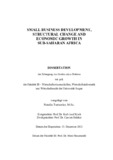Citation link:
http://dx.doi.org/10.25819/ubsi/10044Files in This Item:
| File | Description | Size | Format | |
|---|---|---|---|---|
| Dissertation_Natalia_Tsatsenko.pdf | 1.44 MB | Adobe PDF |  View/Open |
| Dokument Type: | Doctoral Thesis | metadata.dc.title: | Small business development, structural change and economic growth in Sub-Saharan Africa | Other Titles: | Entwicklung kleiner Unternehmen, Strukturwandel und Wirtschaftswachstum in Afrika südlich der Sahara | Authors: | Tsatsenko, Natalia | Institute: | Fakultät III - Wirtschaftswissenschaften, Wirtschaftsinformatik und Wirtschaftsrecht | Free keywords: | Entwicklung kleiner Unternehmen, Kleine und mittelständische Unternehmen, KMU-Politik, Struktureller Wandel, Wirtschaftswachstum, Klimawandel, Landwirtschaft, Arbeitsproduktivität, Reallokation von Arbeitskräften, Afrika südlich der Sahara, Formelle Institutionen, Unternehmertum, Small Business Development, Small and Medium-Sized Enterprises, SME-Policy, Structural Change, Economic Growth, Climate Change, Agriculture, Labor Productivity, Labor Reallocation, Sub-Saharan Africa, Formal Institutions, Entrepreneurship | Dewey Decimal Classification: | 330 Wirtschaft | GHBS-Clases: | QAA | Issue Date: | 2021 | Publish Date: | 2022 | Abstract: | This thesis covers four topics based on the intersection of the fields of entrepreneurship and development economics: (a) African small business development, including SME policies; (b) the process of structural change in Sub-Saharan Africa; (c) the special role of agriculture in modern African development; (d) relationship between institutions and entrepreneurship in developing and developed countries in the world. Chapter 1 introduces the research problem, the research framework, and the main strands of literature that served as the basis for this work, and then gives an overview of each chapter and its main conclusions. Chapter 2 deals with different aspects related to SME development in Sub-Saharan Africa and how SMEs could be embedded into the process of structural change using Ghana and South Africa as a case study. Chapter 3 deals with one of the directions of the economic development process in the Sub-Saharan African region and uncovers the questions about the importance of the agricultural sector in that region and the impact of climate change on crop yields. Chapter 4 provides new insight into the structural change process in Ghana over 1990 and 2018 by studying the pace and pattern, and also seeks answers to what sector plays a key driver of economic performance between 1990 and 2018 and how the direction and pattern of structural change in Ghana coincides with the overall trend in Africa. The evidence from Chapter 3 and Chapter 4 suggests that for sustainable economic development in the future for Africa, it needs to promote several sectors and not only one. Chapter 5 explores the relationship between formal institutions and entrepreneurship based on the sample of efficiency-driven countries (refer to developing) and innovation-driven countries (refer to developed). This chapter contributes to the existed literature by examining the entrepreneurial activities at early and mature stages which makes it possible to reveal how different quality of institutional dimensions have the different effect on a business that has started recently and a business that has existed for several years. |
DOI: | http://dx.doi.org/10.25819/ubsi/10044 | URN: | urn:nbn:de:hbz:467-21213 | URI: | https://dspace.ub.uni-siegen.de/handle/ubsi/2121 |
| Appears in Collections: | Hochschulschriften |
This item is protected by original copyright |
Page view(s)
587
checked on Dec 25, 2024
Download(s)
413
checked on Dec 25, 2024
Google ScholarTM
Check
Altmetric
Items in DSpace are protected by copyright, with all rights reserved, unless otherwise indicated.

